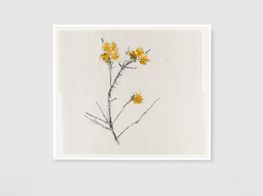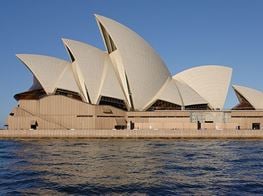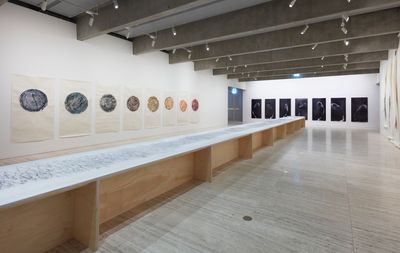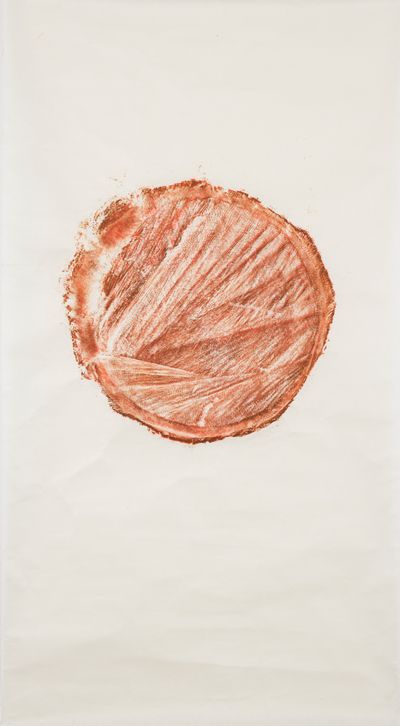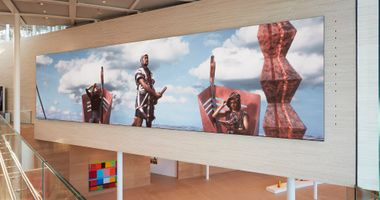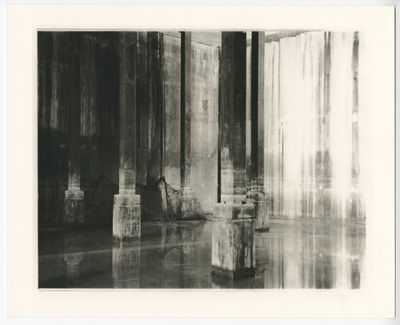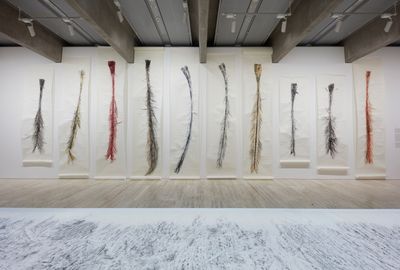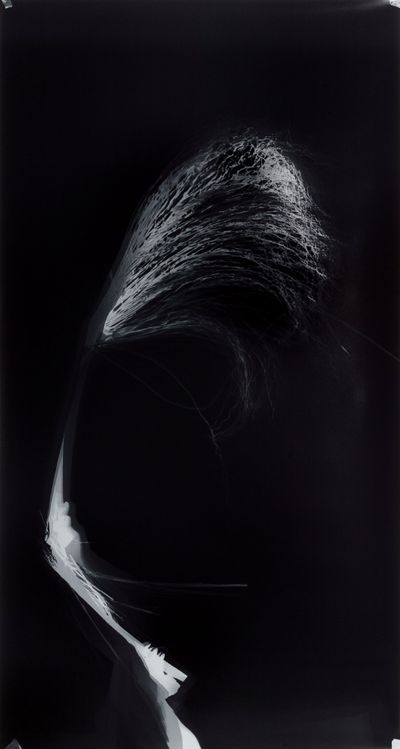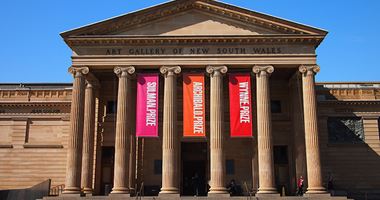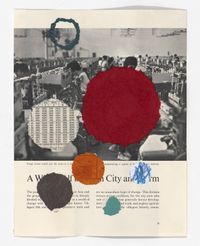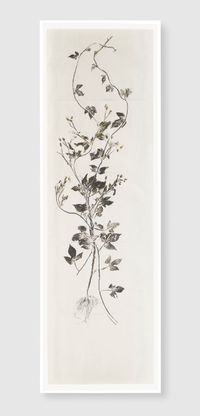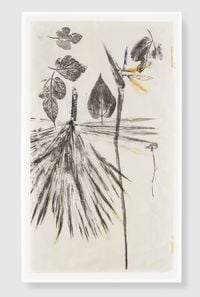Simryn Gill: Clearing the Carbon Sink, Building Carbon Copies
On the lower level of the Art Gallery of New South Wales (AGNSW) is a mortuary of sorts. Cast in warm fluorescent light is the open casket of a 110-year-old Canary Island date palm, Phoenix canariensis, that once stood on what is now the footprint of the Sydney Modern Project.
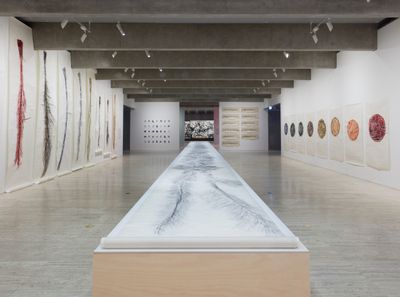
Simryn Gill, Clearing (2020–2022). Commissioned for the Sydney Modern Project at the Art Gallery of New South Wales (AGNSW). © Simryn Gill. Exhibition view: From Here, for Now, AGNSW, Sydney (5 November 2022–12 February 2023). Photo: © AGNSW, Mim Stirling.
When Simryn Gill made a graphite rubbing—a frottage—of the carefully uprooted tree's trunk in early 2020, she was unaware that the day of its intended replanting would never come. The rubbing was executed on site, with the tree laying horizontally on the ground. But the palm was soon discovered to be infested with the destructive pest insect Diocalandra frumenti, the lesser coconut weevil.
Though the Canary Island date palm is a relatively robust species, with its defined root ball allowing it to successfully survive transplants at a large scale, arborists advised that the palm's infestation made it unlikely to survive replanting. Importantly, it was also likely to infect existing trees at the site of its rehoming.
Just weeks later, in March 2020, New South Wales went into a Covid-19 lockdown. Its purgatory short-lived, the palm later arrived in pieces on the porch of Gill's home, at the artist's request. Describing her affinity for this particular tree, Gill said 'it struck me because it lay in this complicated territory of being something that is heritage, and yet needs to go'.
This particular Canary Island date palm was planted in 1909. As its common name indicates, the species is native to the Canary Islands off the northwestern coast of Africa. Gill's own research revealed that it was probably a second-generation planting, with the original lineage coming from Kew Gardens in London.
Revered for its stately appearance, these Canary Island palms were exported around the world to temperate climates and planted throughout Australia from the late 19th century to the early 20th century. It resembles an archetypal palm tree, with its single tall, slender trunk and spiky crown.
Curator Wayne Tunnicliffe notes the 'melange of colonial culture' represented in the AGNSW site as we see it today—'a Grecian sandstone temple to the arts, built in relentlessly local material from this site, and Canary Island date palms from off the west coast of Africa, planted to give our city a more subtropical appearance.'
In my own home in Aotearoa New Zealand, Canary Island date palms populate inner city parks and reserves, along with the Australian native Moreton Bay fig trees, Ficus macrophylla. The ficus was another species Gill encountered in the early stages of Clearing, her commission for Sydney Modern Project as part of the exhibition From Here, for Now (5 November 2022–12 February 2023) at AGNSW.
Clearing found its beginnings in 2019, in a site visit by the artist with Wayne Tunnicliffe to the underground tank that is now an exhibition space within the Sydney Modern Project. The former naval oil tank was lined with ficus roots that had pushed their way through. Their determination attracted the attention of Gill, who has long been an archivist of her surroundings—particularly in and around Sydney and Malaysia, where she lives.
Working across disciplines including sculpture, photography, and drawing, Gill considers how changes in context and material adjust meaning. She documents interventions or alterations, zooming in on the relationships between history, place, and culture, often in collaboration with specialist makers and artists.
For the 21st Biennale of Sydney in 2018, Gill presented her 'Untitled (Interiors)' series (2008)—five bronze casts of land fissures that arose in the 2001–2009 drought in southeastern Australia, one of the worst on record for the region. The casts recorded negative spaces in the dry beds of dams and lakes around New South Wales and Canberra, giving form to the less visible marks on the impacted environment.
Also exhibited at the Biennale was Gill's 1998 work Carbon Copy, a 53-part collection of text produced with typewriters, and their carbon copies. Featuring words and statements made by Australian politician Pauline Hanson and former Malaysian prime minister Mahathir Mohamad, Carbon Copy merged rhetoric around immigration in repeated, abstracted blocks of language.
Gill likens the experience of developing Clearing to the German fairy tale Rumpelstiltskin. In the story, a girl is locked up in a tower with straw and a spinning wheel, and ordered to spin the straw into gold by morning on threat of death. While Gill's confinement wasn't quite as unyielding, the two-year period across which Sydney experienced various Covid restrictions enabled the time to process the elements that form Clearing.
Having been made prior to the knowledge that the palm would be condemned, the central frottage in Clearing, in retrospect, foreshadows the damage to the ecological collateral of the Sydney Modern's construction. Tunnicliffe notes that 'the drawing became an unintentional marker—a death shroud, a death mask of that tree before it had to be cut up'. Following this terminal sentence, Gill was compelled to document the palm in its entirety—'I decided to make a complete record of the tree,' she said.
Despite the two-dimensional nature of each of the works, the bodily presence of the Canary Island palm feels tangible. Dissected seed sprays appear almost as dancers in motion in Gill's black-and-white photograms, while sweeping fronds, laboriously rubbed with coloured inks, now hang in their imprinted forms on Japanese paper.
Buckled and curled slightly at the edges, the prints resemble carbon copies hung out to dry. Gill's process of making these prints was informed as much by the immediate sensory feedback of handling the materials as the intent to make a record: 'You're understanding what is under the paper with your fingers and making those decisions blind. This demanded a different reasoning and relationship with the tree.'
The AGNSW building's imposing sandstone facade and seemingly irrevocable inscriptions of artist names (Giotto, Raphael, Titian, and Rembrandt to name a few) betray past aspirations for the 'temple to art'. That the site is Gadigal Country—of which the Aboriginal Gadigal people of the Eora Nation are the traditional custodians—adds further complexity to the continued evolution of the landscape.
On the decision to show Clearing in the existing building, rather than at the new site, Gill states, 'It made sense to locate this project within this building, to mark the connection of the site—it's pinning the two, because it's taken out of that space in between. That exists because this exists; it's a continuity.'
The unveiling of the Sydney Modern Project expansion—an architectural apex with billions of dollars in projected income for the New South Wales economy over the coming decades—drew much fanfare. Less apparent are the ecological bodies substituted or sacrificed to accommodate such structures.
Gill's intention, however, is not to provide authoritative commentary on urbanisation or colonial histories. As much as it documents the imprint of the absent monument, Clearing operates as a marker of spatial and temporal interstices—of lockdowns, construction, evolution.
Like the wax tablets of antiquity, upon which inscriptions were written, erased, and rewritten, the land upon which the Sydney Modern Project now stands gives way to a kind of tabula rasa. Gill concludes, 'I'm interested in what is considered expendable, and when. When is something a pillar of your culture, and when is it something you want to disappear, or are willing to let go?' —[O]

